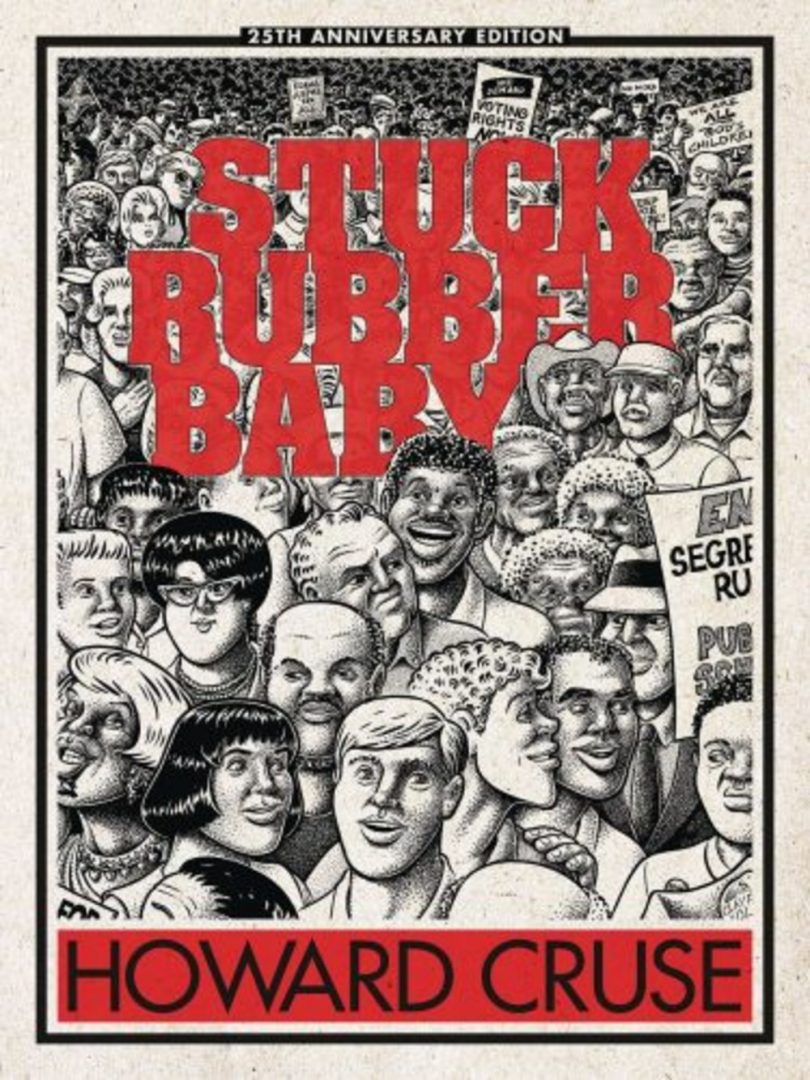‘Stuck Rubber Baby’ by Howard Cruse

Author: Cathy Camper
July 26, 2010
It struck me, while reading Stuck Rubber Baby so many years after its publication in 1995, that its setting, what its author Howard Cruse refers to as “Kennedytime,” makes it the perfect accompaniment to Mad Men and the current nostalgia for the early sixties. Its easy to love Mad Men for its costumed detail and its hindsight winks at sixties foolishness: cigarettes, girdles, nuclear families, and TV… if only we knew then what we know now. But Mad Men never follows black characters home; so far, they stay maids and elevator operators. And little of uncloseted queer life shows up either; titillation, yes, but arts and rights? No.
Cruse’s re-released graphic novel (with a new introduction by Alison Bechdel) explores topics at which Mad Men only hints. The advertising series is set in Gotham City; Cruse’s story takes place in a thinly disguised Birmingham, Alabama. When Mad Men‘s white copyrighter Paul Kinsey goes with his black date Sheila White to Mississippi to register voters, it happens off stage. But when Cruse’s protagonist Toland Polk steps out the front door, civil rights protests surround him. Mad Men’s Salvatore Romano, like Toland, is a closeted gay character. But unlike Toland, Romano has yet to face up to the true consequences his hiding has on gay rights (at least so far).
Cruse’s tale is a brilliant meld of two American coming-of-age stories: civil and gay rights. It follows Toland in the years right after college, and keeps an eye on his circle of friends – his sister (married to the racist Orley); his straight friends Mavis and Riley; their gay friend Sammy; Ginger, a northern civil rights activist who becomes Toland’s girlfriend; and Les, the black preacher’s gay son, who is Toland’s first male lover. As the civil rights movement heats up, it’s impossible for Toland to not take a stand. But his inability to take action is more and more tied to his inability to know himself. The tragedy of the story comes from the denial of civil rights and prejudices against Toland’s sexual preference; redemption comes from freedom.
It’s important to read Cruse’s afterword, penned in the nineties, which details the meticulous research he did to assure that clothing, automobiles, music and other historical references were correct (all pre-Internet). Also note his thanks to others who helped fund the project by buying pages of art work, furnishing him with the money that allowed him to complete the work. This novel, like its characters, survived on the skin of its teeth.
Just as Mad Men stands apart from its predecessors, Cruse’s attention to detail sets this work apart from many other graphical efforts. Cruse’s pen turns out a perfect mix of realism and cartoon, allowing readers to see into the past, but also into the psychology of his characters.
More than that, Cruse has rhythm. Pacing is integral to this story. When Toland dares venture inside the Rhombus, a gay bar, he marvels at the first truly integrated space he’s been in his life. Cruse allows just enough time pass to let that significance sink into the reader’s brain. When another character is lynched, language drops out altogether, as if words dare not express the hideousness of this human act.
Stuck Rubber Baby was published at a time when the graphic novel was a novelty. It came out in the wake of Spiegelman’s Maus, and although of equal brilliance, it never got quite the same acclaim. Most likely, America wasn’t willing to step up to the plate and acknowledge it’s queer history.
Hopefully today it will gain the readership it deserves. Stuck Rubber Baby’s depth of characterization, setting, psychological insight, and history make it a perfect example of how a graphic novel is not simply a compilation of cartoons. This reprinting calls attention to the masterpiece it is, not only in queer literature, but also as an exemplary work in the graphic novel genre, one that deserves to stand as a model of the form for young cartoonists straight and gay.
——
STUCK RUBBER BABY
By Howard Cruse
Vertigo/DC Comics
ISBN: 9781401227135
Paperback; $24.99; 210p



